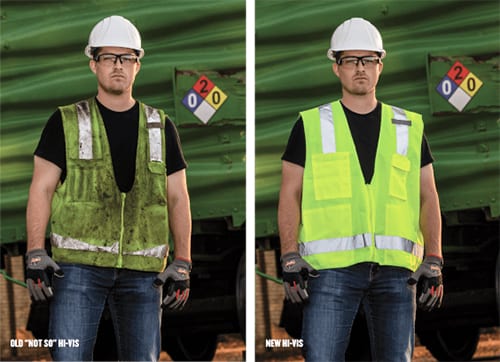 Making sure workers are highly visible is crucial for their safety in a number of industries, especially those involving moving vehicles and equipment. It’s important to understand hi-vis clothing regulations and when to replace worn out reflective PPE.
Making sure workers are highly visible is crucial for their safety in a number of industries, especially those involving moving vehicles and equipment. It’s important to understand hi-vis clothing regulations and when to replace worn out reflective PPE.
Why should you replace hi-vis clothing?
Wearing reflective material and bright colors like yellow, orange and lime makes workers more visible in busy and potentially dangerous work environments. Therefore, it’s necessary to make sure those colors remain bright and easy to notice.
Clothing that’s old, tattered and dirty loses its effectiveness and puts workers at risk of coming in contact with hazards that could lead to injury or death. Replacing hi-vis vests, jackets, coveralls, pants, gloves and other apparel is key to meeting overall safety goals.
Here are some additional reasons to utilize quality hi-vis:
- Identification: Hi-vis apparel helps distinguish authorized individuals from unauthorized individuals in a work area.
- Marketing: Clothing items that are considered hi-vis can often feature your company logo, further promoting your brand.
- Productivity: Clothing that’s bright and distinguishable makes it easier to supervise employees.
When should you replace hi-vis?
Gear has a service life. As a general rule of thumb, hi-vis clothing that’s been worn longer than six months should be inspected for its effectiveness.
Of course, work environments vary and will have different effects when it comes to hi-vis wear and tear. Ultimately, garments should no longer be worn if they’re torn, cracked, severely faded, burned or covered in dirt. If the brightness level has gone down significantly, it might be time to revisit regulations and upgrade to newer PPE.
ANSI/ISEA: Where to find hi-vis clothing regulations
Hi-vis garments should meet standards put forth by the American National Standards Institute (ANSI) and the International Safety Equipment Association (ISEA). These standards mostly focus on design requirements and performance testing criteria for hi-vis clothing.
These standards address three different types of hi-vis garments and what fluorescent/retroreflective class they fall into.
Types of hi-vis garments
- Type O (off-road): These workers aren’t required to wear hi-vis apparel, but they’re in an environment with moving equipment where visibility is a concern.
- Type R (roadway): These workers are exposed to moving equipment and vehicles that are part of roadway traffic.
- Type P (public safety): These workers are often police officers, firefighters and emergency response personnel.
Classes of hi-vis garments
- Class 1: These garments are suited to low-risk situations involving slow-moving vehicles and ample room between the workers and traffic, as well an environment where the workers are easily seen.
- Class 2: These garments are worn by workers who encounter medium hazard levels from vehicles that exceed 25 miles per hour, inclement weather and attention being diverted from oncoming traffic.
- Class 3: These garments involve high hazard levels, often in the form of fast-moving vehicles and low visibility. They feature retroreflective material added to the arms and legs.
- Class E: These are the highest class of hi-vis garments, often involving pants, leg gaiters and vests.
You can find hi-vis in a number of different styles to meet both requirements and your personal preference.
If you’re not seen, you’re not safe
Employee safety is paramount, which is why it’s important to stay visible on the job. Visibility can mean the difference between life and death.
This blog post was written in partnership with Ergodyne. Check out their original article, “Understanding hi-vis standards and the importance of replacing used high-visibility apparel.”
Related articles
4 Essential Construction Safety Tips for Contractors
Oil and Gas PPE Standard Practices Address Industry Safety Hazards